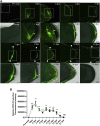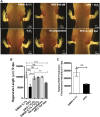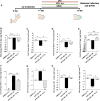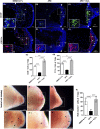Post-amputation reactive oxygen species production is necessary for axolotls limb regeneration
- PMID: 36092695
- PMCID: PMC9458980
- DOI: 10.3389/fcell.2022.921520
Post-amputation reactive oxygen species production is necessary for axolotls limb regeneration
Abstract
Introduction: Reactive oxygen species (ROS) represent molecules of great interest in the field of regenerative biology since several animal models require their production to promote and favor tissue, organ, and appendage regeneration. Recently, it has been shown that the production of ROS such as hydrogen peroxide (H2O2) is required for tail regeneration in Ambystoma mexicanum. However, to date, it is unknown whether ROS production is necessary for limb regeneration in this animal model. Methods: forelimbs of juvenile animals were amputated proximally and the dynamics of ROS production was determined using 2'7- dichlorofluorescein diacetate (DCFDA) during the regeneration process. Inhibition of ROS production was performed using the NADPH oxidase inhibitor apocynin. Subsequently, a rescue assay was performed using exogenous hydrogen peroxide (H2O2). The effect of these treatments on the size and skeletal structures of the regenerated limb was evaluated by staining with alcian blue and alizarin red, as well as the effect on blastema formation, cell proliferation, immune cell recruitment, and expression of genes related to proximal-distal identity. Results: our results show that inhibition of post-amputation limb ROS production in the A. mexicanum salamander model results in the regeneration of a miniature limb with a significant reduction in the size of skeletal elements such as the ulna, radius, and overall autopod. Additionally, other effects such as decrease in the number of carpals, defective joint morphology, and failure of integrity between the regenerated structure and the remaining tissue were identified. In addition, this treatment affected blastema formation and induced a reduction in the levels of cell proliferation in this structure, as well as a reduction in the number of CD45+ and CD11b + immune system cells. On the other hand, blocking ROS production affected the expression of proximo-distal identity genes such as Aldha1a1, Rarβ, Prod1, Meis1, Hoxa13, and other genes such as Agr2 and Yap1 in early/mid blastema. Of great interest, the failure in blastema formation, skeletal alterations, as well as the expression of the genes evaluated were rescued by the application of exogenous H2O2, suggesting that ROS/H2O2 production is necessary from the early stages for proper regeneration and patterning of the limb.
Keywords: Ambystoma mexicanum; axolotl; blastema; hydrogen peroxide; immune cells; limb regeneration; macrophages; reactive oxygen species.
Copyright © 2022 Carbonell-M, Zapata Cardona and Delgado.
Conflict of interest statement
The authors declare that the research was conducted in the absence of any commercial or financial relationships that could be construed as a potential conflict of interest.
Figures










Similar articles
-
Hydrogen peroxide is necessary during tail regeneration in juvenile axolotl.Dev Dyn. 2022 Jun;251(6):1054-1076. doi: 10.1002/dvdy.386. Epub 2021 Jun 24. Dev Dyn. 2022. PMID: 34129260
-
Responses to amputation of denervated ambystoma limbs containing aneurogenic limb grafts.J Exp Zool A Comp Exp Biol. 2003 May 1;297(1):64-79. doi: 10.1002/jez.a.10263. J Exp Zool A Comp Exp Biol. 2003. PMID: 12911114
-
Gallium nitrate: effects on cartilage during limb regeneration in the axolotl, Ambystoma mexicanum.J Exp Zool. 2002 Sep 1;293(4):384-94. doi: 10.1002/jez.10116. J Exp Zool. 2002. PMID: 12210121
-
The axolotl limb blastema: cellular and molecular mechanisms driving blastema formation and limb regeneration in tetrapods.Regeneration (Oxf). 2015 May 11;2(2):54-71. doi: 10.1002/reg2.32. eCollection 2015 Apr. Regeneration (Oxf). 2015. PMID: 27499868 Free PMC article. Review.
-
DNA repair during regeneration in Ambystoma mexicanum.Dev Dyn. 2021 Jun;250(6):788-799. doi: 10.1002/dvdy.276. Epub 2020 Dec 17. Dev Dyn. 2021. PMID: 33295131 Review.
Cited by
-
Wide-scale identification of novel/eliminated genes responsible for evolutionary transformations.Biol Direct. 2023 Aug 11;18(1):45. doi: 10.1186/s13062-023-00405-6. Biol Direct. 2023. PMID: 37568147 Free PMC article.
-
Regeneration of Lumbriculus variegatus requires post-amputation production of reactive oxygen species.Dev Growth Differ. 2025 Feb;67(2):104-112. doi: 10.1111/dgd.12961. Epub 2025 Jan 21. Dev Growth Differ. 2025. PMID: 39837571 Free PMC article.
-
Cellular and Molecular Triggers of Retinal Regeneration in Amphibians.Life (Basel). 2023 Sep 28;13(10):1981. doi: 10.3390/life13101981. Life (Basel). 2023. PMID: 37895363 Free PMC article. Review.
-
Characterization of regeneration initiating cells during Xenopus laevis tail regeneration.Genome Biol. 2024 Oct 1;25(1):251. doi: 10.1186/s13059-024-03396-3. Genome Biol. 2024. PMID: 39350302 Free PMC article.
-
Molecular Signatures Integral to Natural Reprogramming in the Pigment Epithelium Cells after Retinal Detachment in Pleurodeles waltl.Int J Mol Sci. 2023 Nov 29;24(23):16940. doi: 10.3390/ijms242316940. Int J Mol Sci. 2023. PMID: 38069262 Free PMC article.
References
-
- Arenas Gómez C. M., Gómez Molina A., Zapata J. D., Delgado J. P. (2017b)., 4. Oxford, England, 227–235. 10.1002/reg2.93 Limb regeneration in a direct-developing terrestrial salamander, Bolitoglossa ramosi (Caudata: Plethodontidae): Limb regeneration in plethodontid salamanders Regeneration - DOI - PMC - PubMed
LinkOut - more resources
Full Text Sources
Research Materials
Miscellaneous

